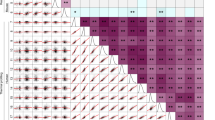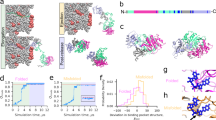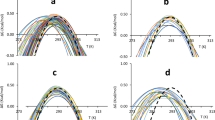Abstract
Folding of tendamistat, an inhibitor of α-amylase, is a fast two-state process accompanied by two minor slow reactions, which were assigned to prolyl isomerization. In a proline-free variant, 5% of the molecules still fold slowly with a rate constant of 2.5 s−1. This reaction is caused by a slow equilibrium between two populations of unfolded molecules. The time constant for this equilibration process, its sensitivity to LiCl and its temperature dependence identify it as a cis-trans isomerization of nonprolyl peptide bonds. Although nonprolyl peptide bonds have the cis conformation populating only ∼0.15% in unfolded proteins, their large number generates a significant fraction of slow-folding molecules. This emphasizes that heterogeneous populations in an unfolded protein can induce complex folding kinetics on various time scales.
This is a preview of subscription content, access via your institution
Access options
Subscribe to this journal
Receive 12 print issues and online access
$189.00 per year
only $15.75 per issue
Buy this article
- Purchase on Springer Link
- Instant access to full article PDF
Prices may be subject to local taxes which are calculated during checkout







Similar content being viewed by others
References
Jackson, S.E. & Fersht, A.R. Folding of chymotrypsin inhibitor 2. 1. Evidence for a two-state transition. Biochemistry 30, 10428–10435 (1991).
Jackson, S.E. How do small single-domain proteins fold? Folding Des. 3, R81–R91 (1998).
Baldwin, R.L. & Rose, G.D. Is protein folding hierarchic? II. Folding intermediates and transition states. Trends Biochem. Sci. 24, 77–83 (1999).
Brandts, J.F., Halvorson, H.R. & Brennan, M. Consideration of the possibility that the slow step in protein denaturation reactions is due to cis–trans isomerism of proline residues. Biochemistry 14, 4953–4963 (1975).
Schmid, F.X. & Baldwin, R.L. Acid catalysis of the formation of the slow-folding species of RNase A: evidence that the reaction is proline isomerization. Proc. Natl. Acad. Sci. USA 75, 4764–4768 (1978).
Colon, W., Wakem, L.P., Sherman, F. & Roder, H. Identification of the predominant non-native histidine ligand in unfolded cytochrome c. Biochemistry 36, 12535–12541 (1997).
Yeh, S.-R., Takahashi, S., Fan, B. & Rousseau, D.L. Ligand exchange in unfolded cytochrome c. Nature Struct. Biol. 4, 51–56 (1998).
Pflugrath, J., Wiegand, I., Huber, R. & Vértesy, L. Crystal structure determination, refinement and the molecular model of the α-amylase inhibitor Hoe-467A. J. Mol. Biol. 189, 383–386 (1986).
Schönbrunner, N., Koller, K.-P. & Kiefhaber, T. Folding of the disulfide-bonded β-sheet protein tendamistat: Rapid two-state folding without hydrophobic collapse. J. Mol. Biol. 268, 526–538 (1997).
Tanford, C. Protein denaturation. Part B. The transition from native to denatured state. Adv. Prot. Chem. 23, 218–282 (1968).
Schmid, F.X. Mechanism of folding of ribonuclease A. Slow refolding is a sequential reaction via structural intermediates. Biochemistry 22, 4690–4696 (1983).
Kiefhaber, T. In Methods in molecular biology, vol. 40 (ed. Shirley, B.A.) 313–341 (Humana Press, Totowa, NJ; 1995).
Szabo, Z.G. In Comprehensive chemical kinetics, vol. 2 (eds Bamford, C.H. & Tipper, C.F.H.) 1–80 (Elsevier Publishing Company, Amsterdam; 1969).
Kiefhaber, T., Quaas, R., Hahn, U. & Schmid, F.X. Folding of ribonuclease T1. 1. Existence of multiple unfolded states created by proline isomerization. Biochemistry 29, 3053–3061 (1990).
Balbach, J. & Schmid, F.X. In Protein folding: frontiers in molecular biology (ed. Pain, R.) 212–249 (Oxford University Press, Oxford; 2000).
Nall, B.T., Garel, J.-R. & Baldwin, R.L. Test of the extended two-state model for the kinetic intermediates observed in the folding transition of ribonuclease A. J. Mol. Biol. 118, 317–330 (1978).
De Young, L.R. et al. RhNGF slow unfolding is not due to proline isomerization: Possibility of a cystine knot loop-threading mechanism. Protein Sci. 5, 1554–1566 (1996).
Otting, G., Liepinsh, E. & Wüthrich, K. Disulfide bond isomerization in BPTI and BPTI(G36S): An NMR study of correlated mobility in proteins. Biochemistry 32, 3571–3582 (1993).
Fraser, R.R., Boussard, G., Saunder, J.K., Lambert, J.B. & Mixan, C.E. Barriers to rotation about the sulfur –sulfur bond in acyclic disulfides. J. Am. Chem. Soc. 92, 3822–3823 (1971).
Scherer, G., Kramer, M.L., Schutkowski, M., Reimer, U. & Fischer, G. Barriers to rotation of secondary amide peptide bonds. J. Am. Chem. Soc. 120, 5568–5574 (1998).
Odefey, C., Mayr, L. & Schmid, F.X. Nonprolyl cis/trans peptide bond isomerization as a rate-determinig step in protein unfolding and refolding. J. Mol. Biol. 245, 69–78 (1995).
Pohl, F.M. Temperature-dependence of the kinetics of folding of chymotrypsinogen A. FEBS Lett. 65, 293–296 (1976).
Radzicka, A., Pedersen, L. & Wolfenden, R. Influence of solvent water on protein folding: free energies of solvation of cis and trans peptides are nearly identical. Biochemistry 27, 4538–4541 (1988).
Schmid, F.X. Proline isomerization in unfolded ribonuclease A. The equilibrium between fast-folding and slow-folding species is independent of temperature. Eur. J. Biochem. 128, 77–80 (1982).
Fischer, G., Heins, J. & Barth, A. The conformation around the peptide bond between P1 and P2 positions is important for catalytic activity of some proline-specific proteases. Biophys. Biochim. Acta 742, 452–462 (1983).
Kofron, J.L., Kuzmic, P., Kishore, V., Colon-Bonilla, E. & Rich, D.H. Determination of kinetic constants for peptidyl prolyl cis–trans isomerases by an improved spectrophotometric assay. Biochemistry 30, 6127–6134 (1991).
Reimer, U. et al. Side-chain effects on peptidyl-prolyl cis/trans isomerization. J. Mol. Biol. 279, 449–460 (1998).
Levitt, M. Effect of proline residues on protein folding. J. Mol. Biol. 145, 251–263 (1981).
Brandts, J.F., Brennan, M. & Lin, L.-N. Unfolding and refolding occur much faster for a proline-free protein than for most proline-containing proteins. Proc. Natl. Acad. Sci. USA 74, 4178–4181 (1977).
Herning, T., Yutani, K., Taniyama, Y. & Kikuchi, M. Effect of proline mutations on the unfolding and refolding of human lysozyme: the slow refolding kinetic phase does not result from proline cis–trans isomerization. Biochemistry 30, 9882–9891 (1991).
Walkenhorst, W.F., Green, S. & Roder, H. Kinetic evidence for folding and unfolding intermediates in staphylococcal nuclease. Biochemistry 36, 5795–5805 (1997).
Maki, K., Ikura, T., Hayano, T., Takahashi, N. & Kuwajima, K. Effects of proline mutations on the folding of staphylococcal nuclease. Biochemistry 38, 2213–2223 (1999).
Weiss, M.S., Jabs, A. & Hilgenfeld, R. Peptide bonds revisited. Nature Struct. Biol. 5, 676 (1998).
Thirumalai, D. In Statistical mechanics, protein structure, and protein substrate interactions (ed. Doniach, S.) 115–134 (Plenum Press, New York, NY; 1994).
Chan, H.S. & Dill, K.A. Transition states and folding dynamics of proteins and heteropolymers. J. Chem. Phys. 100, 9238–9257 (1994).
Bryngelson, J.D., Onuchic, J.N., Socci, N.D. & Wolynes, P.G. Funnels, pathways, and the energy landscape of protein folding: A synthesis. Prot. Struct. Funct. Genet. 21, 167–195 (1995).
Sabelko, J., Ervin, J. & Gruebele, M. Observation of strange kinetics in protein folding. Proc. Natl. Acad. Sci. USA 96, 6031–6036 (1999).
Haas-Lauterbach, S. et al. High yield fermentation and purification of tendamistat disulfide analogues secreted by Streptomyces lividans. Appl. Microbiol. Biotech. 38, 719–727 (1993).
Santoro, M.M. & Bolen, D.W. Unfolding free energy changes determined by the linear extrapolation method. 1. Unfolding of phenylmethanesulfonyl α-chymotrypsin using different denaturants. Biochemistry 27, 8063–8068 (1988).
Renner, M., Hinz, H.-J., Scharf, M. & Engels, J.W. Thermodynamics of unfolding of the α-amylase inhibitor tendamistat: correlations between accessible surface area and heat capacity. J. Mol. Biol. 223, 769–779 (1992).
Bieri, O. et al. The speed limit for protein folding measured by triplet–triplet energy transfer. Proc. Natl. Acad. Sci. USA 96, 9597–9601 (1999).
Author information
Authors and Affiliations
Corresponding author
Rights and permissions
About this article
Cite this article
Pappenberger, G., Aygün, H., Engels, J. et al. Nonprolyl cis peptide bonds in unfolded proteins cause complex folding kinetics. Nat Struct Mol Biol 8, 452–458 (2001). https://doi.org/10.1038/87624
Received:
Accepted:
Issue Date:
DOI: https://doi.org/10.1038/87624
This article is cited by
-
A native to amyloidogenic transition regulated by a backbone trigger
Nature Structural & Molecular Biology (2006)



